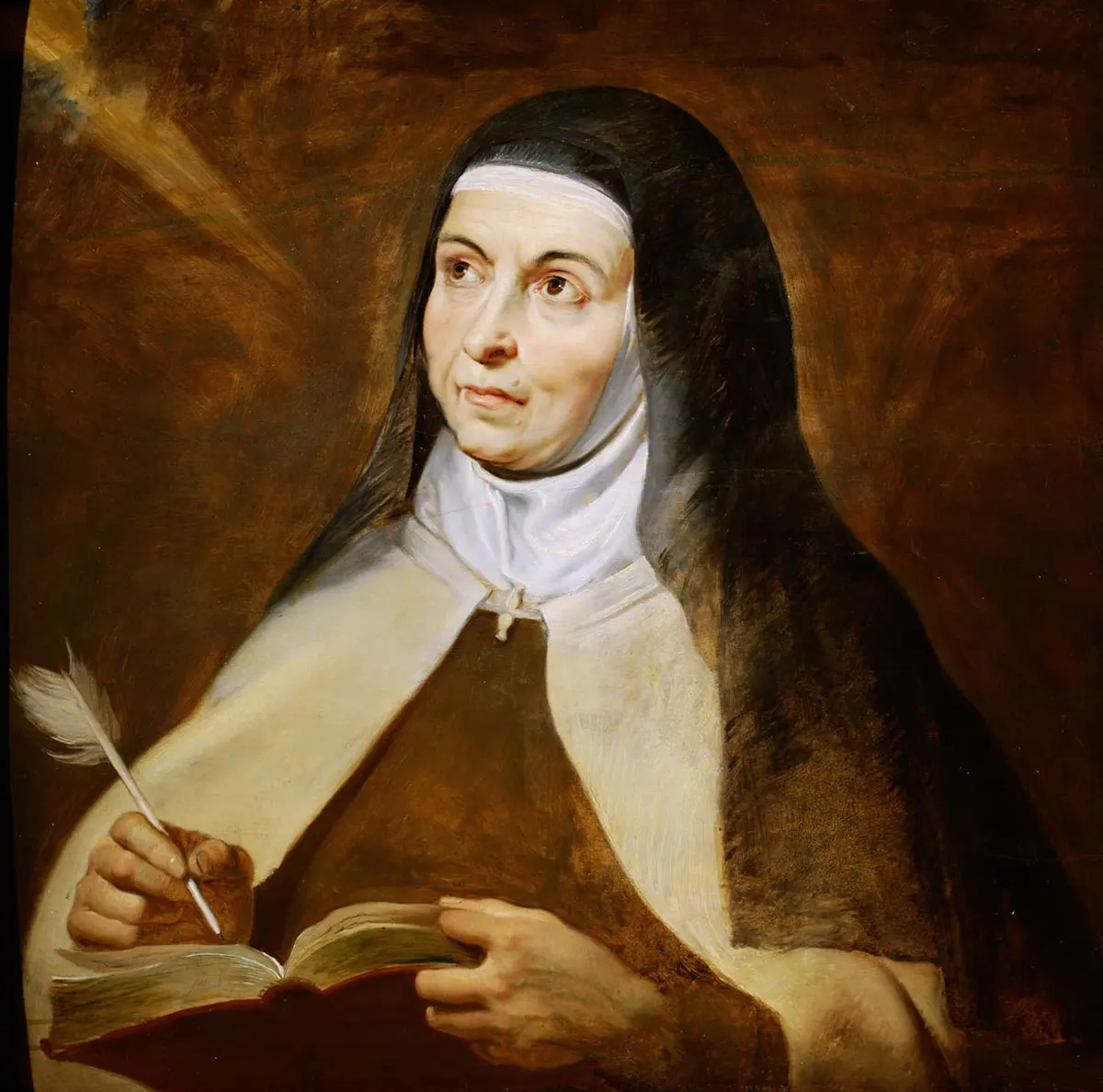By Sangeeta Singh-Kurtz @sangeetaskurtz
Watching Saint Maud, investigating the "God Orgasm"
We’ve spent about an hour with Maud when the young home care nurse sits on the edge of her bed, lines the soles of her shoes with paper cutouts of Mary Magdalene, and methodically secures the photos with thumbtacks. The tacks point up, towards heaven, but also Maud’s bare feet—which she then slips into her shoes. Her skin punctures with a blood-chilling pop. As she walks on metal splinters through her bleak English seaside town, her face conveys no pain. Just shivery, titillated bliss.
When we first meet Saint Maud's titular character (Morfydd Clark) she seems lucid enough, but as her religious fervor escalates, her grasp on reality loosens. There’s an eroticism to her piety. “It’s like he’s physically in me,” Maud says, of God. She’ll be boiling water or walking up the stairs when she’ll suddenly jerk still, gasp and sigh, her cheeks flushing and her knees buckling. It looks an awful lot like an orgasm.
Could this phenomenon, which we’ll call “the God orgasm,” be real? Or does it exist exclusively onscreen?
There’s plenty of evidence towards the latter. Most recently, we witnessed shades of the God orgasm in See (2019), a series set in a dystopian future where everyone is blind, and the chief villianesse masturbates while reciting the Lord’s Prayer in order to speak with God. Horny prayer also shows up in Robert Duvall’s The Apostle (1997), which follows an Evangelical pastor whose sermons leave him aroused, and The Devils (1971), in which nuns have group sex with a statue of Jesus. There’s also cinematic demon sex in Jennifer’s Body (2009), and sex with angels, à la City of Angels (1998). But the closest—or at least most notorious—cousin to Saint Maud is The Exorcist (1973), in which the possessed young Regan (Linda Blair) stabs herself repeatedly in the vagina with a crucifix.
When I set out to determine whether the God orgasm exists outside of the movies, I quickly came across Kelly Deutsch. A former nun and spiritual advisor, Deutsch wrote a blog post titled, “Prayer and Orgasm Have More in Common Than You Think.” In it, she describes an intense version of prayer: “It’s like my heart blooms open, to a place deeper than I knew existed—and God pours himself out there. Sometimes it leaves me breathless!”
‘It’s like he’s physically in me,’ Maud says, of God.
Though initially met with skepticism, Deutsch argues that her experience is not uncommon. In fact, there’s plenty of historic evidence—some coming from established Christian saints, no less—who describe their prayer as orgasmic. She directs her readers to several juicy poems by Rumi, John of The Cross, and, my personal favorite, Teresa of Ávila, a Catholic saint who had vivid religious visions and a Danielle Steel-like flair for writing:
“When He touches me I clutch the sky’s sheets / the way other lovers do… Any real ecstasy is a sign / you are moving in the right direction / don’t let any prude tell you otherwise.”
On the phone, I ask Deutsch what orgasmic prayer feels like and she pauses for a long time. “It’s kind of like trying to describe chocolate to someone who's never had it,” she says. Is there a physical aspect to it? She pauses again. “Sometimes there is this sense of being penetrated by something that is infinite, in the depths of your being… like when you gasp deeply, ahhhh,” she says, with a sharp, noisy, I’ll-have-what-she’s-having inhale. “You come out of the gasp feeling more alive than you’ve ever been.”

With Christian orgasmic prayer proving ineffable, I turn to tantra for clues. Tantric sex was recently one topic of Netflix’s docu-series (Un)Well (2020), which traces the Westernization of the ancient Indian religion. The episode contains a cameo from Melanie and Scott McClure, two such New Age, white tantrics who once described their 18-hour orgasm to the New York Post. “For just a little while, I felt at one with God,” Scott told the paper.
When I spoke with Scott, he described his orgasms—which are not ejaculatory—as “energy orgasms” that produce a full-body buzz. Scott used to be agnostic, but no longer doubts the existence of God after so many of these experiences. When I ask if he prays, he says not in the traditional sense. Sometimes he “talks to God, but God is love.” So.
It was clearly time to turn to science. Could there be a biochemical explanation for all of this?
Barry R. Komisaruk is a neuroendocrinologist and psychologist at Rutgers University, and the first thing he tells me is that science still doesn’t have a complete picture of what happens when women orgasm. “We do know that a symphony of neurotransmitters are released, and they all have different functions,” Komisaruk says. “People describe orgasms as altered states of consciousness, so it’s not outlandish that people are reporting these experiences.” (He does note that the scientific definition of orgasmic climax lasts 10 to 15 seconds. Sorry to the McClures.)
It’s kind of like trying to describe chocolate to someone who’s never had it.
Sex therapist Stephen Snyder, author of Love Worth Making: How to Have Ridiculously Great Sex in a Long-Lasting Relationship, says something similar: “Many people describe intense sexual arousal—and the soul-shaking orgasms that can happen as a result—as a spiritual or mystical experience that can soften or obliterate the felt boundary between self and other, or self and the universe.”
A referendum on the God orgasm was proving elusive.
Komisaruk described a handful of possible medical explanations, including epileptic seizures. “There’s great similarity between seizures and orgasm; both have a very high generalized activation of various brain systems,” he says, adding that seizures are often accompanied by hallucinatory auras, and pointing to a case in which a woman refused her medication because she enjoyed her seizures so much. Komisaruk also notes that cervically-induced orgasms can produce especially intense feelings. These women often describe their cervical orgasms in abstract terms, using words like “cosmic” and “consciousness-enhancing.”
But a cervical orgasm requires penetration. Is it possible to have one without physical stimulation? Could you have one by simply thinking about, oh, I don’t know—God?
Turns out, yes. In a study with psychotherapist Gina Ogden, Komisaruk looked into what Ogden has termed “thinking off,” as in the ability to have orgasms through thought. The doctors observed ten women who purportedly had this ability (superpower?) and asked them to produce two orgasms: one just by thinking (of whatever turned them on, which ranged from erotic thoughts to long walks on the beach to yoga) and one via clitoral stimulation. The physiological measurements taken during each climax were identical. “In other words, they were really thinking themselves into orgasm,” Komisaruk says, a note of wonder in his voice.

So, what does this mean for the God orgasm?
It seems as though run-of-the-mill orgasms are already so awe-inspiring that an inquiry into God’s role in them has left us with more questions than answers. Whether it’s Maud’s self-flagellating ecstasy, New Age tantrics, or thinking-off, until we figure out why orgasms exist in the first place, who’s to say God can’t get at least some credit? As if in agreement, Snyder points me towards Lorenzo Bernini’s sculpture of Teresa of Ávila, completed in 1652, which finds her suspended in almost impolite pleasure: mouth open in a moan, eyes closed in bliss, head and habit tossed back. “If she isn’t having an orgasm, then she's having something darn close,” he says. And as Saint Teresa herself might say: Don’t let any prude tell you otherwise.



